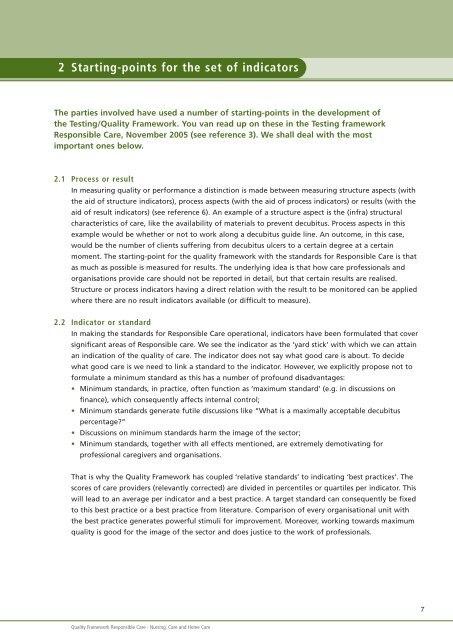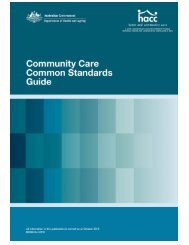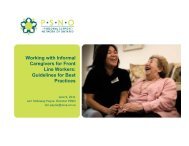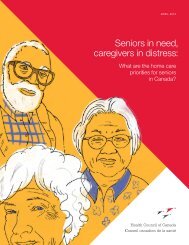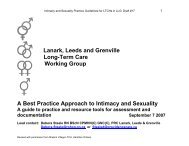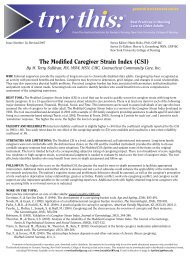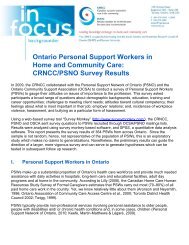Quality Framework Responsible Care - BioMed Central
Quality Framework Responsible Care - BioMed Central
Quality Framework Responsible Care - BioMed Central
You also want an ePaper? Increase the reach of your titles
YUMPU automatically turns print PDFs into web optimized ePapers that Google loves.
2 Starting-points for the set of indicators<br />
The parties involved have used a number of starting-points in the development of<br />
the Testing/<strong>Quality</strong> <strong>Framework</strong>. You van read up on these in the Testing framework<br />
<strong>Responsible</strong> <strong>Care</strong>, November 2005 (see reference 3). We shall deal with the most<br />
important ones below.<br />
2.1 Process or result<br />
In measuring quality or performance a distinction is made between measuring structure aspects (with<br />
the aid of structure indicators), process aspects (with the aid of process indicators) or results (with the<br />
aid of result indicators) (see reference 6). An example of a structure aspect is the (infra) structural<br />
characteristics of care, like the availability of materials to prevent decubitus. Process aspects in this<br />
example would be whether or not to work along a decubitus guide line. An outcome, in this case,<br />
would be the number of clients suffering from decubitus ulcers to a certain degree at a certain<br />
moment. The starting-point for the quality framework with the standards for <strong>Responsible</strong> <strong>Care</strong> is that<br />
as much as possible is measured for results. The underlying idea is that how care professionals and<br />
organisations provide care should not be reported in detail, but that certain results are realised.<br />
Structure or process indicators having a direct relation with the result to be monitored can be applied<br />
where there are no result indicators available (or difficult to measure).<br />
2.2 Indicator or standard<br />
In making the standards for <strong>Responsible</strong> <strong>Care</strong> operational, indicators have been formulated that cover<br />
significant areas of <strong>Responsible</strong> care. We see the indicator as the ‘yard stick’ with which we can attain<br />
an indication of the quality of care. The indicator does not say what good care is about. To decide<br />
what good care is we need to link a standard to the indicator. However, we explicitly propose not to<br />
formulate a minimum standard as this has a number of profound disadvantages:<br />
• Minimum standards, in practice, often function as ‘maximum standard’ (e.g. in discussions on<br />
finance), which consequently affects internal control;<br />
• Minimum standards generate futile discussions like “What is a maximally acceptable decubitus<br />
percentage?”<br />
• Discussions on minimum standards harm the image of the sector;<br />
• Minimum standards, together with all effects mentioned, are extremely demotivating for<br />
professional caregivers and organisations.<br />
That is why the <strong>Quality</strong> <strong>Framework</strong> has coupled ‘relative standards’ to indicating ‘best practices’. The<br />
scores of care providers (relevantly corrected) are divided in percentiles or quartiles per indicator. This<br />
will lead to an average per indicator and a best practice. A target standard can consequently be fixed<br />
to this best practice or a best practice from literature. Comparison of every organisational unit with<br />
the best practice generates powerful stimuli for improvement. Moreover, working towards maximum<br />
quality is good for the image of the sector and does justice to the work of professionals.<br />
7<br />
<strong>Quality</strong> <strong>Framework</strong> <strong>Responsible</strong> <strong>Care</strong> - Nursing, <strong>Care</strong> and Home <strong>Care</strong>


